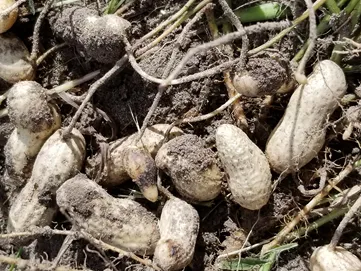
With the changing of seasons comes mixed emotions for myself. While I will miss the warm evenings and vast amounts of growth that the summer season brings, the fall has its’ benefits as well. In northeastern North Carolina, the start of fall is always marked by the peanuts being ready for harvest, and is especially important in the area that I live in. The benefits and uses from peanuts are countless, and it is a wonderful vegetable to grow.
Yes, you read that correctly – a Vegetable, and not a nut. Despite its name, pea-nut, peanuts are actually not a nut and really are a vegetable of the legume family, which includes plants such as peas and beans. A common name for the peanut from the old times was actually the Goober Pea.
Peanuts are one of several plants that are nitrogen-fixing plants, which means you don’t need to add nitrogen to the soil to grow them. On the roots are small little nodules that convert the nitrogen in the air to a useable form of nitrogen in the soil, which make peanuts an excellent crop to rotate with plants that have high nitrogen needs, such as corn and tobacco. Without getting too scientific on this, these nodules work with bacteria known as rhizobia and work symbiotically with the bacteria, soil, and plant to convert the nitrogen into usable form. These nodules can be seen in the picture below (they are the little small balls).
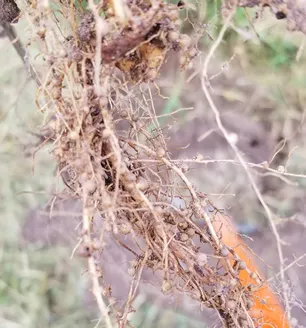
Growing peanuts have a rich history throughout the world, dating back as far as 7,500 years and originating from South America. Originally peanuts were grown mostly as animal feed in the US, and were not popularly eaten as a human food until the early 1900’s, after the research and developments of many scientists such as Carver and promoted by the Department of Agriculture.
While technically they are considered a sub-tropical plant, they grow fantastic throughout most of the US, and do best from zone 5b through zone 10b. In the far northern climates, they do best when started inside approximately 1 month before the last spring frost. They have a long growing season, and require moderately warm soil for sowing. They require full sun, and do not grow as well in areas with moderate shade. Typical grow seasons for peanuts last around 120-150 days. In the area I live, I plant in mid-May for an early October harvest.
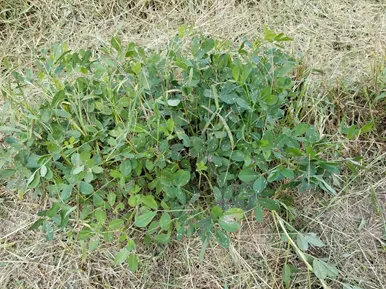
Peanuts are extremely easy to grow, and can be done with ease, even for beginner gardeners. While they do best when growing in the ground, it is also possible to grow them in containers with decent results. Unlike many other plants, their fertilizer needs are very minimal, and most growers never even have to apply anything to their soil. Calcium is the only nutrient that is occasionally needed to be added for a successful peanut grow (only if soil analysis determines that you’re lacking in calcium). The most important thing to keep in mind for growing peanuts is soil pH – they prefer sandy and/or loose soils rich in organic matter in the pH range of 5.8 – 6.2.
Soil temperatures should be at least in the 60-70 degree F range for optimal planting conditions. Peanuts can be either planted in their shells or can be removed from their shells for planting. If removing them from the shell, be sure not to damage or remove the reddish skin, or the seeds will not germinate. For areas farther North, plan to sow your seeds only about 1.5 inches down to allow them to sprout sooner; for areas in the South, sow your seeds approximately 4 inches down. Plant seed peanuts 6 inches apart, and thin them out to around 12 inches after sprouting.
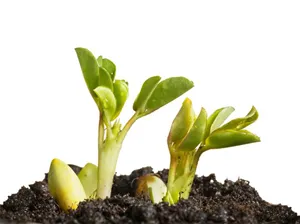
Photo compliments of Leaf.tv
After your plants are sprouted and thinned out, it is now mostly a waiting game. Once plants reach 6 inches, begin cultivating the soil and keep weeds down to a minimum at this point. Placing grass clippings or straw around the plants are a fantastic way to reduce weeds while also allowing the soil to remain loose for pod growth. Also ensure that you give the plants around an inch of water each week if rain doesn’t come regularly, but be sure not to overwater them.
After the plants reach 12 inches, hill some dirt up around the plants, but be sure not to bury the leaves too much as you can introduce a fungus infection that will cause black spots to form on the leaves, which can completely kill the plant if it goes untreated. This hilling will further help reduce weeds along with allowing loose soil for the peanut pods to grow in. Peanuts are initially slow growing, but will really start to explode in growth around 30-40 days.
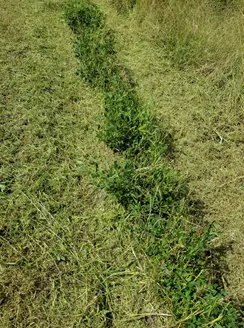
Around 6-8 weeks after sprouting, the plants will begin to flower and will continue to flower for a majority of the growing season – the flowers will come in waves which lead to varying levels of maturity in the peanuts in the ground. Once the flowers are pollinated and the flowers begin to wilt, the immediate surrounding foliage will fall off and the “pegs” (sharp tip where the flower was) will begin to bend towards the ground. These pegs will then penetrate the ground and 2-3 peanuts will grow at each one of these locations. Once you see this happening, be sure not to be too rough with cultivating around the plants as you may damage or pull up the growing peanuts. A healthy peanut plant will yield approximately 30-50 peanuts per plant.
Once you’ve patiently waited 120-150 days, your peanuts are now ready for harvest. You can either wait for the leaves to begin to turn yellow, or as I prefer to do, pull a couple test plants and check for maturity. While light frosts will not be detrimental to your plants, you should really try to plan your grow out as to where you will have them harvested before the frost arrives.
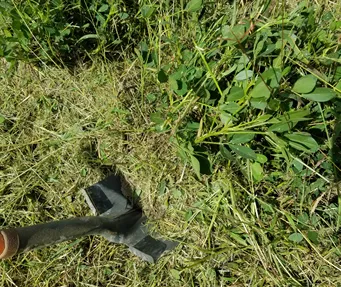
To ensure that your peanut losses are minimal, I like to take shovel and insert it in the ground at about a 45-degree angle, located a few inches away from the outermost pegs. I then will pry the soil up slightly, and then grab the base of the plant from the ground. Once you carefully pull the plant out the ground, it should look as does the picture below.
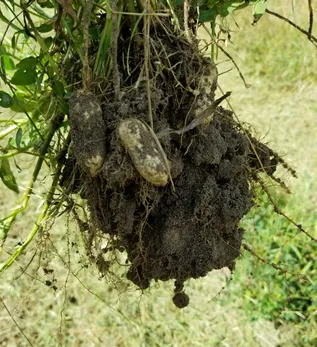
Gently shake the dirt off, while taking care not to do it too violently or you may drop peanuts down. As previously mentioned, the peanuts growing in the ground will be at varying levels of maturity, so don't be startled if a couple of the peanuts are past maturity or have not not reached maturity yet. Once you’ve gotten the excess dirt off, lay the peanuts out on the ground and allow them to begin to dry in the sun – typically for a couple days at minimum. The only time you won’t need to dry them is if you plan to boil the peanuts; otherwise, drying them will be necessary.

After that, take them to a warm area to hang, and dry them for an additional few weeks. When the peanuts have finished drying, they are now ready to be roasted and processed however you may wish. Raw peanuts store fantastically, and when stored in proper conditions, they can easily store for over a year if frozen – approximately 6 months in fridge. You will want to store them while still in their shell to extend shelf-life. If you see any signs of mold, be sure to dispose of them immediately as the aspergillus fungus can grow in those conditions, and is known to be carcinogenic to humans.
Hope this was helpful and feel free to post any questions you may have below.
Did any of you grow peanuts this year?